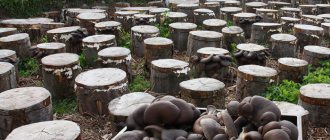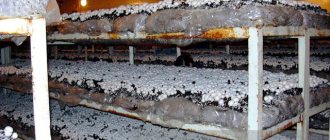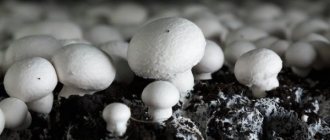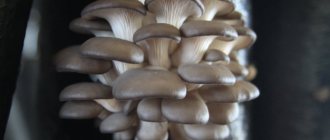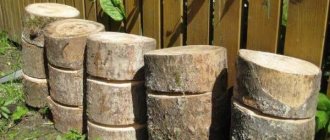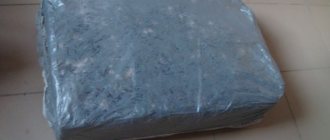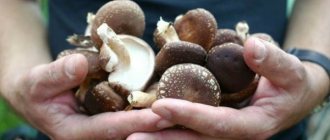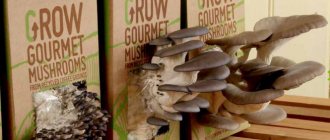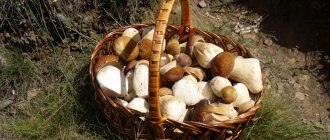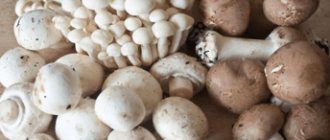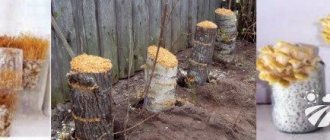The porcini mushroom is called the king of the forest, because even the youngest specimens look quite impressive due to their thick stem and fleshy cap. Unfortunately, in recent years fewer and fewer boletus mushrooms have been found in forests. This happens both due to climate change and due to the fact that some mushroom pickers do not collect correctly, which damages the mycelium and reduces yields.
If you don’t have time to go to the forest and look for boletus mushrooms, this does not mean that you will have to give up delicious wild mushrooms. You can easily grow them in your garden if you use the helpful tips and growing instructions provided in our article.
Planting material
You can purchase mushroom mycelium at places where gardening supplies are sold (in a store, at a fair) or you can independently obtain spores (or part of the mycelium) from wild champignons.
Store assortment
Seed, "Aelita", "Prestige", etc.) offer champignon mycelium in small packages
When purchasing, pay attention to the expiration dates, and store the package unopened in a dry and cool place, possibly in the refrigerator (but not in the freezer)
Two-spore champignon (white)
The most common champignon, familiar to us, highly productive and very tasty.
Royal champignon (brown)
This is a special species with a light brown cap. It has an intense aroma and richer taste. Gourmets believe that in terms of taste it is close to porcini mushrooms.
Brazilian champignon (brown medicinal)
It is believed that this type of champignon, with a scaly brown cap, has unique healing properties: normalizes the functioning of the liver, kidneys and gastrointestinal tract, restores immunity after exposure to strong drugs; It’s as if he’s even fighting cancer.
INTERESTING!
There are also other edible types of champignons with their own external characteristics and shades of taste.
Disputes from wild plants
In our natural conditions, white champignon (bisporous) is found everywhere, and obtaining its planting material is not difficult.
You can get spores for reproduction. To do this, the caps of overgrown, old champignons are filled with natural water (rain, river or spring) and left for a couple of days. The resulting mixture is used to water the prepared bed.
Live mycelium (mycelium) is also used. In the place where the mushrooms grow directly, after the rain, pieces of soil the size of a matchbox are cut out. They serve as planting material.
Beneficial properties of porcini mushrooms
Boletus contains protein, which is quite easily digestible. They are rich in vitamins and a large number of microelements: vitamins B, C, and D, carotene, riboflavin, potassium, calcium, iron, selenium, manganese, phosphorus, chromium. But they may not be useful to all people.
Young children should avoid eating mushrooms. And people with gastrointestinal problems and a tendency to allergies should eat them carefully, taking into account the characteristics of their body.
Growing porcini mushrooms using mycelium
You can grow porcini mushrooms in your country house using mycelium. Before planting, the top layer of soil is removed under the tree. Compost is placed on the bare area, and pieces of mushroom mycelium are placed on top. You need to lay it out in a checkerboard pattern. Then place the removed turf on top and water well. One tree requires 3 buckets of water. But you need to water carefully so as not to wash away the soil.
To achieve a better and faster result, cover the area with fallen leaves or straw. This helps retain moisture, since the mycelium should not be allowed to dry out. It is best to add fertilizer to the water with which the area is watered. In the cold season, the mycelium is covered with branches, straw and fallen leaves - in a thick layer so that the soil does not freeze too much. In the spring, this “cover” needs to be removed. Porcini mushrooms will appear as soon as the mycelium takes root. And they will grow in this area for up to 4 years. When watered with fertilizers - up to 7 years.
How to grow porcini mushrooms in the country
The value of porcini mushrooms is explained by their rarity. Unlike russula and other common species that can grow almost anywhere, boletus requires special soil and climatic conditions for the development of fruiting bodies.
Note: When planning to grow mushrooms in the country, be prepared for the fact that they will have to create the same conditions as in the forest. In this case, you will be able to harvest a rich harvest throughout the season without leaving your summer cottage.
First of all, you should make sure that the fruiting bodies have enough moisture. If the humidity level drops below 60%, they dry out, even if there is enough moisture in the soil itself.
Temperature also plays an equally important role. Spores germinate already at +9 degrees, but for normal development of fruiting bodies they require heat - from +19 to +27 degrees. That is why the boletus collection season most often occurs in early, warm autumn. Under such conditions, fruiting bodies can germinate and develop within 30 days.
Figure 1. Growing boletus in the country
Accordingly, if you manage to create similar conditions in your own summer cottage, you can save time and effort by picking mushrooms directly in the garden (Figure 1). In addition, when planting boletus mushrooms, you will be absolutely sure that you are collecting edible specimens, and not poisonous look-alikes, which are very skillfully disguised as real porcini mushrooms.
Planting mushrooms in the garden
In order for champignons to become a common crop in the country, you need not only to plant them correctly. The choice of landing site is of great importance. Mushrooms do not need light, so you can choose shaded places for them. If there are no such zones, then the area with the mycelium will have to be specially shaded.
The principle of arranging the place where the mycelium will develop is universal. In order to understand how to grow champignons at the dacha in open ground, it is enough to know that these mushrooms need to be provided with a large supply of dead organic matter, which must constantly decompose. This is why there is a mixture of manure and straw. Manure is organic matter that will feed the mycelium in the first years of its development. Decaying straw (grass, leaves, sawdust, etc.) is food for mushrooms, which will be available to them in a few years.
On the beds
Placing crops on beds is necessary to create specific conditions and fencing this area with plantings. Beds are not only a separate area, but also an area raised above the main soil. This placement allows you to protect the plantings from waterlogging and create special conditions.
Mushrooms are rarely planted in open ground beds. The advisability of such placement arises in the case of constant waterlogging.
If the bed is well shaded, then caring for champignons will require little time and effort.
A trench 1 m wide is dug in a shaded lowland. The length of the trench is determined at will and in connection with the characteristics of the location. The width of 1 m is determined by the convenience of caring for the bed and harvesting. The trench is filled with nutrient substrate according to the scheme described above. Only the top layer of soil in which the mycelium is located should rise 10-15 cm above the ground level. The edges of the bed must be reinforced with boards or bricks.
With this arrangement, the mycelium will be located in an area of sufficient moisture, and rotting organic matter will be located in an area of waterlogging. If the bed is well shaded, then caring for champignons will require little time and effort.
In the hole
A layer of compost is placed at the bottom of the pit. The top should be covered with fresh grass or leaves. Then a layer of soil is laid. After watering, mushrooms are sown on the soil in the form of spores or finished mycelium. From above, the seed is again covered with a thin layer of soil and leaves. After this, the pit can be covered with a lid. With this device, moisture will not evaporate, and the temperature will be constant.
Sowing mycelium
At home, the purchased mycelium must be activated before planting. To do this, it is placed in a dark place with a temperature of about +20°C. This should be done 2-3 days before planting. If the mycelium begins to develop in the warmth (a clearly visible “web” of hyphae appears), the humidity inside the package increases and the mushroom smell intensifies, this means it’s time to start planting.
It is recommended, if possible, to disinfect the soil before sowing. This is done to combat diseases and pests. Only the top layer of soil into which the mycelium is immersed is subject to disinfection. This should only be done if you are planting purchased mycelium or sowing spores. If soil is transferred from the forest, then disinfection does not make sense.
Growing champignons in a box.
How to grow boletus mushrooms in the country
Temperature and humidity conditions are far from the only condition for successfully growing boletus mushrooms in the country. Since in nature these mushrooms are found mainly in pine forests, birch, oak and aspen groves, you should try to reproduce similar conditions at home.
Note: The choice of wood plays an important role because it is the tree species mentioned above that have a positive effect on the growth and development of the mycelium.
It is advisable to plant in those areas of the site where similar trees grow. Preference should be given to coniferous species, since they not only promote the development of mycelium, but also have an antiseptic and antibacterial effect, destroying pathogens.
It is important that the boletus mycelium does not tolerate proximity to fruit trees and does not take root at all. Therefore, if there are no oaks, aspens, pines or birches on your site, simply place the mycelium near any wooden building, preferably from coniferous trees. Naturally, you can’t count on huge harvests in this case, but you will be able to collect enough boletus mushrooms to eat.
Mushroom picker secrets
Substrate preparation
Experienced mushroom pickers take the preparation of the substrate very seriously and begin work a month before the actual laying of the mycelium.
The main component of the substrate is fallen leaves, which are collected in the spring and stored in 10 buckets. In addition, you will need 1 bucket of rotten wood or fruit tree sawdust and 1 bucket of clean cow manure without straw.
For the substrate you can use seed husks, leaves, straw and even pine needles
If you haven’t had time to stock up on leaves, straw, sunflower seed husks and pine needles do a great job. The main condition is to use last year’s material, which is easily rotten.
The resulting composition is poured with a 1% solution of nitrate (ammonium nitrate) and covered with a waterproof material. Every week the mass is shoveled until it becomes homogeneous. This process will take about a month.
Ammonium nitrate is an excellent complex fertilizer for mushrooms
Planting mycelium
It's no secret that mushrooms grow in small families; the mycelium is located at a depth of 5-10 cm. Having found such a family in the forest, carefully use a shovel to dig out a layer of earth 30 cm thick.
These are the small families that mushrooms live in natural conditions.
Before planting, the resulting layer must be divided into 5-6 parts and planted on the prepared bed in a checkerboard pattern, retreating from each other at least 30 cm. In this case, the depth of the mycelium embedding should not exceed 3-5 cm.
Immediately after planting, the bed is watered and “hidden” under a layer of leaves to obtain a favorable microclimate. All further care of the mushroom bed will consist of regular watering and shelter for the winter.
Oyster mushrooms
This mushroom can even be grown indoors, for example in a garage, cellar, basement. The harvest can be harvested all year round. The room is pre-treated with a four percent lime solution. It is closed for 2 days and then ventilated until the smell disappears completely.
There should be two rooms in the room. In the first one the mycelium will germinate, and in the second one the mushrooms should be grown.
Now we need to prepare the ground. It may consist of sawdust, sunflower seed husks, ground corn cobs, and straw. You will also need to add one or more types of compost here. The soil mixture is soaked in warm water for 30 minutes. The liquid is drained and the substrate is squeezed out. Then it is poured with boiling water for 7 hours and left under pressure. Then the liquid is drained again and the soil is squeezed out. Limestone, gypsum, superphosphate and urea are added to it.
The finished wet substrate is poured into a plastic bag, in which small holes with a diameter of about 2 cm are made. A distance of approximately 20 cm is maintained between them. Mushrooms will grow through these holes.
The soil must be poured into the bags in a certain order. First, make a 15-20 cm layer of nutritious, moist soil. Mycelium is laid out on it, which should fill the space of the bag by 2/3. He is tied up and taken to the first room. It is best to hang the bags from the ceiling, but you can also arrange them in rows.
The temperature in this room should be approximately 24°C. In this case, the temperature in the bags should reach 28°C. The air should be very humid, almost 95%. Mushrooms sprout in the dark.
Myceliums need to be ventilated periodically. As soon as the mycelium begins to germinate, the bags are transferred to the second room. Here you need to provide a sufficient amount of oxygen. The humidity should be as high as in the first room, but the temperature decreases. It ranges from 12 to 18°C.
In the second room, artificial lighting is created (fluorescent lamp). Daylight hours should last 12 hours. When the mushrooms begin to sprout, the holes need to be widened. 8 days after the first small oyster mushrooms appear, the first harvest can be harvested.
Preparation of planting material
These wonderful mushrooms can be grown using mycelium or spores.
Controversy
To receive a dispute, you must do the following:
- You should choose 10–15 large boletus mushrooms. It is better to choose specimens with caps of at least 15 cm.
- The caps are immersed in water, maintaining a proportion of 160–200 g per 1 liter.
- Then sugar or alcohol is dissolved based on the ratio of 3 tablespoons per 10 liters.
- The dishes with the mixture are placed in a warm place with fairly high humidity for a day.
- Then the raw materials are ground to a homogeneous consistency and can be planted.
Mycelium
The mycelium is the vegetative body of boletus mushrooms. It is produced in specialized laboratories. The weighed material is sealed in plastic containers. This material should be purchased at the rate of 0.5 kg per 1 m² of planting area.
Important! When transporting or storing mycelium, it is important to maintain a low temperature regime. The shelf life of products from domestic manufacturers is short - 2–3 months at a temperature of +2…+4°С
Increasing the temperature above these indicators sharply shortens these periods, and temperatures above +30 ° C for several hours can make the mycelium unusable. You can make mycelium not only in the laboratory, but also yourself. To do this, a section of the plucked boletus fruiting body is placed in a test tube that has undergone a sterilization process. For 14 days it is placed in a warm place with a temperature of +24…+26°C. The resulting mycelium is planted in the substrate.
- A good mycelium should look like this:
- according to external parameters, it must be painted white, without yellowness or greenish inclusions;
- have the characteristic smell of mushrooms;
- have uniformity of mycelium grains, which can be checked by cutting a couple of pieces.
Planting of mycelium occurs in the following sequence:
- First, it is placed in the cold for a couple of hours;
- then grind the mycelium in the bag;
- The mycelium and soil are mixed, and then placed in a prepared place for growing in a layer of up to 7 cm.
Methods of growing mushrooms
To get a great harvest, it is important to properly breed mushrooms at home. There are several options:
- Planting mycelium. A special seed preparation is purchased. You need to make a hole on the site. Sawdust and leaves are placed at the bottom. The package with seeds indicates the area that needs to be sown with fungal spores. The seeds are taken out of the package, mixed with a special growth activator, as well as nutritious soil (chernozem). After sowing, the mycelium must be thoroughly watered, covering the soil with fallen leaves.
- Planting mushroom seedlings. Pieces of mushrooms are soaked in water for a day and then planted in the ground. This method is suitable for growing wild mushrooms. The seedlings are introduced into the soil under the tree. It is watered generously with the same water in which the mushroom pieces were soaked.
- Transplanting a tree with mycelium in the roots. A suitable specimen must be found in the forest. This method is labor-intensive and therefore rarely used.
For beginners, it is better to choose the first method. Over time, you will be able to try other techniques.
Substrate
When wondering whether it is possible to grow porcini mushrooms yourself, be patient. Wherever you decide to grow mushrooms, it is better to initially prepare and collect the substrate necessary for growth. This is a specific composition that is sprinkled on the area prepared for the mycelium.
For each type of mushroom it is special and has different properties. For example, for whites, wood shavings, leaves, pine bark, straw, sawdust and husks are best suited. All these ingredients must be sterilized to eliminate the presence of harmful bacteria. Afterwards, the substrate must be buried in the mycelium, mixed with soil and watered abundantly.
Transfer
If you decide to grow mushrooms by transplanting, you need to dig up the mycelium and then plant it in the ground where deciduous or coniferous trees or shrubs grow. You need to dig up planting material from the same tree where you plan to plant the porcini mushroom.
In front of the selected tree, at a distance of 50 cm from the trunk, you need to dig a hole 30 cm deep. Fallen leaves and sawdust are laid down. A layer of soil is poured onto them, on which the dug mycelium is planted. The soil is watered abundantly. The top of the spores should be covered with leaves. Watering is carried out in the first 2-3 weeks.
Growing mycelium in the garden
You can plant champignons, oyster mushrooms, milk mushrooms, chanterelles, etc. in the garden using compost or grain-type mycelium. They buy it in the store. The first mushrooms will appear in the next season, and a full harvest will appear in 2 years. The optimal time for planting mycelium is May or September.
Growing champignons in the country from mycelium is highly productive - the first harvest can be harvested in 30-40 days. Any place in the garden with natural or artificial shading is suitable for setting up mushroom beds. Algorithm for planting mycelium and caring for champignons:
- In the fall, dig trenches 30 cm deep and 40 cm wide. Leave 50 cm between future beds.
- Place drainage (broken shards, brick, crushed stone) on the bottom in a layer of 10 cm.
- Place fresh grass on top, fill with slurry, sprinkle with humus and leave until spring. To prepare slurry, fill ½ barrel (bucket) with horse or cow manure and fill with water to the edge of the container. Leave for 5-10 days.
- Prepare special compost for laying the mycelium. To do this, 10 kg of wet straw is enriched with 10 kg of manure (horse or cow), mineral fertilizers: 350 g of ammonium nitrate, 200 g of superphosphate. The ingredients are mixed every 5 days for a month.
- Fill the trenches with compost to create ridges 30 cm high.
- Place the mycelium in 5 cm recesses made in a checkerboard pattern 15 cm apart.
- Caring for mycelium consists of periodically moistening the ridges with settled rainwater from a watering can.
- After 14-21 days, the compost will be covered with a white coating of overgrown mycelium. It is required to sprinkle it with sand and sawdust (1:1) in a layer of 5-10 cm.
- Continue to moisten the substrate as the top layer dries 5 cm until the crop ripens.
The technology for growing wild mushrooms from mycelium differs from planting champignons only in the choice of location and preparation of the substrate. The plot of the future mushroom plantation should be located 50-70 cm from the tree of the species next to which the mushrooms grow in natural conditions. Proximity of the composition of the substrate to natural is a priority. It is better to transfer the soil from the forest to the site of the future mushroom plantation.
Mycelium quickly takes root in the country house and in the garden if the growing rules are followed. This is the advantage of the method. Disadvantage of the method:
- painstaking preparatory work to create mushroom beds;
- cost of purchasing mycelium;
- Constant care of the mushroom plantation is required.
Harvesting
Depending on the timing of planting, the harvest of country mushrooms occurs in spring or autumn. The ripening of the crop occurs in waves, so you need to visit the mushroom bed every week. When harvesting, you should adhere to the following rules:
- Each mushroom is cut at the root of the stem with a sharp knife so as not to damage the mycelium.
- The sections should be mulched with compost to prevent the mycelium from drying out.
- After each harvest, the mushroom plantation should be watered with a watering can to activate further growth of the crop.
- If the mushrooms are overripe, it is better to use them for spore propagation.
Harvest dates for different types of mushrooms:
Champignon. The first harvest is ready for harvest 30-40 days after the mycelium is laid, subsequent ones - every 5-10 days.
Honey mushrooms. The harvest is harvested twice a year - in spring and autumn.
Boletuses appear at the end of summer.
Chanterelles. Fruiting begins in June-July.
Porcini. The harvest is harvested in spring or autumn, depending on the planting date and weather conditions.
Growing boletus (redhead)
As you already understood from the name, this mushroom mainly grows in aspen groves. Sometimes it can be found in mixed forests. If you undertake to grow a mushroom in the country, then the issue of choosing a site should be approached as carefully as in the case of porcini mushroom.
Boletus, like many other forest mushrooms, is a mycorrhizal fungus. This means that it forms a symbiosis with the roots of trees, i.e. mutually beneficial cohabitation. Therefore, the site must have aspen, birch or oak. Plant your future plantation in the shade of these trees.
Boletuses can be bred using:
- Spore (mushroom seedlings)
Spores form on the underside of the caps of overgrown mushrooms. This is what you should prepare: add water and leave for several hours. Use the resulting infusion of spores in water to water the area you have chosen for growing mushrooms. The caps can also be dried and used as seed. Germinating spores form mycelium (mycelium).
- Fruiting bodies
Collect young boletuses in the forest, chop them and bury them in your area in the top layer of soil in the shade of trees.
- Mycelium
Wild mycelium can be collected from the forest by digging up along with the soil and trees. This way you will move the mycelium to your site, just as in the case of boletus mushrooms. Or you can buy ready-made mycelium in the store.
Setting up a mushroom plantation and care
Prepare compost. Spread a plastic film on the ground, lay leaves and wood dust with manure on it in layers, taken in a ratio of 9:1. Fill the pile with warm water and leave for a week. During this time it should warm up to a temperature of 35-40°C. Now you can shovel it until smooth and leave it for another 5 days.
Redheads can be planted from mid-May to September (in warmer regions - from early May).
In the selected area around the tree, dig a hole 30 cm deep and 2 sq.m. in area. If the tree's roots are at or close to the surface of the soil, remove only the top layer.
Fill the hole with compost. If it is deep, then lay the compost to ground level; if it is shallow, lay it out in layers, alternating compost (10-12 cm) and soil (5-6 cm), until the height of the layers reaches 50 cm above ground level.
Then, at a distance of 25-30 cm, make holes 20 cm deep. Dip pieces of boletus mycelium into them and cover them with soil. Immediately water the plantation with water at the rate of 20 liters per 1 sq.m and cover with a layer of fallen leaves or forest litter.
Don’t forget to insulate the mycelium for the winter
In order for the mycelium to take root, it is useful to feed it with a sugar solution: 10 g of sugar per 10 liters of water. In summer, keep the soil slightly moist. Water the area periodically, especially during dry periods. For the winter, cover it with a layer of fallen leaves, moss or spruce branches, and in the spring do not forget to remove them.
Under favorable conditions, boletus fruiting begins the very next year after the plantation is established. The yield is 5-15 mushrooms per 1 sq.m. With proper care, the mushroom clearing will delight you with a harvest for 4-5 years. After this period, the mushroom mycelium must be replanted using the same method.
Types of mushrooms suitable for growing in the garden
Almost any fruiting bodies can be grown in the country house and in the garden. At the same time, due to the lack of a vegetative period for mushrooms, they can be grown all year round, except winter. But in order for home cultivation of mushrooms to be successful, it is necessary to properly organize a new environment and growing conditions for them. First of all, we are talking about the choice of place for planting fruiting bodies, the quality of the soil and the availability of tree varieties similar to the forest microclimate - pine, spruce, aspen, birch, oak. This allows the mycelium to seamlessly connect with the root system of the plant, fully feed and utilize excess moisture.
The most successful options for growing edible forest mushrooms on a personal plot are:
- oyster mushrooms;
- milk mushrooms;
- Polish mushrooms;
- boletuses or redheads;
- porcini mushrooms or porcini mushrooms;
- boletus;
- yellow chanterelles;
- boletus;
- flywheels chestnut or brown mushrooms;
- russula-dewlaps;
- saffron milk caps;
- honey mushrooms;
- Champignon.
Exotic types of fruiting bodies, such as truffles, also lend themselves well to cultivation in the country. The method of cultivating mushrooms is almost the same, with the exception of the individual varietal characteristics of the product.
Overview of types of porcini mushrooms
- Spruce mushroom. The most common type. The hat is dark brown. The leg is thick and strong.
- Oak mushroom. The cap is brown, but not as dark as that of the spruce species. The leg is long and dense.
- Pine mushroom. The hat is chocolate-colored and can reach a fairly large size in diameter. The leg is also brown.
- Birch mushroom. The hat is light beige. The leg is quite long, barrel-shaped.
- Net mushroom. The size of the cap of this mushroom can reach a maximum of 30 cm. The surface has cracking in the form of a mesh.
- Semi-white mushroom. The cap is yellow or creamy-brown in color. The leg is elongated, long, cylindrical.
Features of cultivation
Mushroom cultivation has virtually nothing in common with the agricultural techniques of growing traditional crops. This is largely due to the fact that mushrooms have a unique structure that distinguishes them from green plants. In the cells and tissues of fungi, unlike most plants, completely different processes take place, due to which they almost do not need sunlight, but at the same time they really love warmth and high humidity of the air and soil (substrate).
Thus, one of the most important nuances of growing mushrooms on a personal plot is to create conditions for them that are as close as possible to their natural growing environment. This involves meeting requirements such as:
- correct selection and preparation of a planting site;
- maintaining optimal light levels, air humidity and soil in the place where mushrooms are planted.
Mushrooms should be grown in shaded areas where direct sunlight does not penetrate. The most suitable in this regard are the tree trunk spaces under deciduous or coniferous trees (mushrooms are planted at a distance of at least 0.5 m from the trunk)
It is important to note that forest mushrooms can only be grown under forest trees, but in no case under fruit crops
Many summer residents grow mushrooms in the shade of a house or outbuildings - for example, behind a barn or bathhouse. First, the area for planting mushrooms is cleared of household and/or vegetable debris and convenient access routes are arranged. The soil at the planting site should be loose, moist (but not swampy!), containing a large amount of organic matter.
Another important nuance that requires the attention of a novice mushroom grower is the correct choice of planting material. To grow mushrooms, store-bought mycelium, mycelium brought from the forest, or seedlings are usually used.
In specialized stores you can find ready-made mycelium of almost all known varieties of mushrooms. Before purchasing, experienced mushroom growers recommend carefully reading the instructions included with the planting material. This recommendation is due to the fact that the cultivation of certain types of mushrooms often requires the fulfillment of specific conditions (for example, planting mycelium strictly near coniferous or, on the contrary, deciduous trees), which are not always acceptable for the owner of a summer cottage.
Planting mycelium brought from the forest is one of the simplest and most effective ways to quickly set up a mushroom plot on your site. In this case, the owner of the plot has an objective opportunity to obtain a harvest from mushrooms adapted to the climatic and weather conditions of his region.
In some cases, it is possible to grow a mushroom plot in a personal plot through seedlings. To do this you need:
- chop fresh mushroom caps and cover them with water for a day;
- prepare a planting site under a tree growing on the site (loosen the soil, add compost);
- pour the resulting infusion onto the prepared area and cover it with rotted leaves.
In the future, it is recommended to water the equipped plot with an infusion prepared in the above manner from any crushed mushroom remains - caps, stems, fragments of mycelium. This will create the most comfortable environment in the soil, thereby speeding up the germination of mushroom seedlings.
Planting and growing mushrooms on a personal plot is carried out throughout the entire summer season - from May to September. Arrangement of plots is carried out in the evening or in cloudy, damp weather. Throughout the growing season, care is taken to ensure that the soil in the plots does not dry out. For this purpose, they are regularly watered, after which they are mulched with rotted leaves.
How to grow porcini mushrooms in a cellar at the dacha
The advantage of growing boletus mushrooms is that they practically do not need special lighting conditions. Accordingly, you can cultivate them even in the basement of a private house.
Such growing conditions will allow you to obtain absolutely complete porcini mushrooms. The only difference will be that due to the lack of sunlight, the caps of such boletus mushrooms will be slightly lighter than those grown in the forest (Figure 2).
To grow porcini mushrooms in the cellar, you need to follow these recommendations:
- The floor, walls and ceiling must be concreted to prevent pathogens from getting into the mycelium. In addition, it is advisable to whitewash the walls with slaked lime to prevent the spread of infection indoors.
- In the basement it is necessary to equip high-quality natural or supply and exhaust ventilation, with the help of which it will be possible to regulate the temperature in the room.
- The optimal temperature for growing porcini mushrooms is considered to be +12+15 degrees. In such conditions, not only will the mycelium germinate, but the fruiting bodies will also develop evenly.
- The basement must maintain a stable humidity level of 80%. Only in such conditions will porcini mushrooms be large enough and fleshy. If the room is too dry, containers of water placed around the perimeter will help increase the humidity.
In addition, it is advisable to equip all ventilation openings with a mosquito net to prevent insects from accidentally getting inside and damaging the crop.
Figure 2. Growing boletus in the basement
When the room is ready for planting, you need to additionally prepare equipment and tools for cultivating boletus mushrooms. First of all, you will need a substrate. Its composition can include sunflower husks, dry corn stalks and sawdust from deciduous or coniferous trees. You cannot use only sawdust from fruit trees as a material, since the boletus mycelium does not get along with them.
Note: Before use, the substrate must be treated with hot water and dried. Only under these conditions will you be sure that the soil will not be infected with pests or pathogens.
You will also need porcini mushroom mycelium, and it is better to use not self-prepared material, but products produced in a special laboratory. You can also use mycelium brought from the forest, but in this case there will be no exact guarantee of a positive result.
You can grow mushrooms in the basement in ordinary boxes or flower pots filled with substrate. Naturally, this process also involves direct sowing of the mycelium, which can be carried out in several ways. Since each of them has its own characteristics, we will look at the main ones in more detail.
Planting mushrooms using mycelium
If the vegetation on your site is quite diverse and includes not only fruit trees, but also coniferous and deciduous trees, you can easily try to grow boletus mushrooms using mycelium brought from the forest (Figure 3).
Note: The mycelium should only be planted under the tree of the same species under which it grew in the forest. Otherwise, it will not take root and the harvest will not work.
To plant boletus mycelium in your own summer cottage, follow these instructions:
- In the selected area under the tree, remove the top layer of soil within a radius of 70 cm from the trunk.
- The depth of the removed soil layer should be 26-28 cm.
- We fill the resulting depression with a nutrient substrate. It should include soil removed from under the tree, some leaves and pine needles, as well as the bark of the tree under which the mycelium will grow.
- The mycelium is laid out on top of this mixture and sprinkled with a layer of sand and pine needles.
Figure 3. Growing from mycelium
After this, the area just needs to be watered from a watering can and you can expect the first mushrooms to appear.
Dilution of the solution
If you don’t know how to properly remove mycelium from the soil in the forest, you can easily prepare a special planting solution from overripe porcini mushrooms or their caps.
To do this, you need to finely chop the overripe boletus mushrooms, add a tablespoon of flour and the same amount of gelatin to the mixture. Then add water to the mixture, mix it thoroughly and water the soil around deciduous or coniferous trees. In this case, from such a mushroom mixture in the soil, mycorrhiza (fungal root) is formed with the root system of the tree, and the first harvest of boletus mushrooms can be harvested in two years.
If you use only caps, they need to be washed and filled with spring or rain water for a day. After this, the water is drained and the caps are ground until smooth. Unlike sowing with a solution, when using the pulp of their caps, the soil under the selected tree must be loosened, watered with water that remains after soaking the caps, and after absorbing the moisture, distribute the pulp evenly and sprinkle it on top with loose and light soil. Next, the planting site needs to be watered regularly, but moderately. When using this method, mushrooms germinate much faster than when sowing with a liquid solution.
Burying mushrooms in the area
If you have collected a large harvest of wild mushrooms, you can always leave a few young specimens to create your own bed. To do this, young porcini mushrooms need to be finely chopped and the pulp buried in the ground near a coniferous or deciduous tree on the site (Figure 4).
Figure 4. Planting a mushroom bed
After this, the area must be watered abundantly. On average, one tree should require about 40 liters of water. However, you should be prepared that you should not expect a quick harvest when using this method, since the first young mushrooms will appear only in the next season. At the same time, the obvious advantage of this method is its high efficiency combined with minimal labor costs.
Growing porcini mushrooms from mycelium
A much more effective method of growing porcini mushrooms on the site is a method that uses special mycelium produced in the laboratory. Such mycelium can be planted in a garden bed as early as May, and sowing work can continue until September.
The technology for growing porcini mushrooms from mycelium is as follows:
- Choose a well-lit and moderately humid area under the tree. In this area you need to remove the top layer of soil. As a rule, one packet of mycelium is designed for an area of 3 square meters.
- At the bottom of the formed hole we lay out a layer of pine needles, leaves and tree bark, under which the mycelium will be located. It is important to take into account that the layer of such a substrate should be about 10 cm thick. Sprinkle humus on top of the substrate.
- We take the mycelium out of the package, mix it with clean sand and distribute it evenly over the substrate. It is also advisable to sprinkle a layer of humus on top, since otherwise the planting material may be washed away by rainwater. On average, the top layer of humus should be 4.5 cm.
- The sown area needs to be watered. To do this, you can use both drip irrigation and a minimal watering can.
In the future, it is necessary to ensure that the plot does not dry out, and the harvest can be harvested from such a bed within five years.
Reproduction by spores
This propagation method is suitable for those who have already managed to grow a few boletus mushrooms on the site. To increase the colony of porcini mushrooms, you should use their spores. To do this, you need to leave one mushroom so that it is overripe. After this, all the pulp should be selected from its cap (Figure 5).
Figure 5. Growing boletus from spores
It should be finely chopped with a knife or passed through a meat grinder to form a paste of uniform consistency. Place this mass in a jar or bottle, add 3 teaspoons of sugar, 20 grams of yeast and fill with spring or rain water. The mixture should be kept in a warm place for about 2 weeks.
After this, dilute 150 grams of gruel in 10 liters of water and filter through several layers of gauze. The resulting liquid just needs to be watered onto the soil around the tree or in the strawberry beds. In order for the spores to penetrate deep into the soil, after such a peculiar sowing it is necessary to additionally water the area. Using this method, the harvest will appear in about a year.
Farming
Champignons are very popular mushrooms, grown by large mushroom farms. But just like that, every summer resident can grow them.
You should know that this mushroom is unpretentious and when cultivating it, the planting location is not so important as the correct growing conditions. At the dacha, mushrooms can be grown in any suitable room or outdoors
First, let's talk about how to grow champignons in a greenhouse. But before that, it’s worth keeping in mind that there are several types of them. This is a white mushroom, cream and brown. The most demanding is the white variety, but the other two are less capricious, but produce much lower yields. And so, a greenhouse for porcini mushrooms is the most optimal place for growing, because maintaining the necessary conditions in it is quite simple.
The most important thing in planting mushrooms is the soil mixture, which must be able to pass moisture and air, be maximally saturated with nutrients, and the presence of carbon dioxide in it must not exceed acceptable standards, otherwise we will receive a substandard product. Forest turf is considered the best soil for a greenhouse. If it is impossible to create such soil, sawdust can be added to the existing soil.
For planting, mycelium is used, which we purchase at a seed store. Or you can cook it yourself. Finely chop old mushrooms that are unsuitable for food and add water at room temperature. Over the course of the day, spores will be released into the water. Before planting them, we warm up the greenhouse to a temperature of twenty-two degrees. And only then we evenly water the ground with the resulting liquid. Next, sprinkle with a centimeter layer of soil. For faster germination of spores, you can cover the sown soil with film.
Further care of the crops consists of maintaining a temperature that should not exceed twenty-six degrees Celsius, constant ventilation and moderate watering. Remember that the mushroom does not tolerate heat well, so do not allow it to overheat. After the first shoots appear, replace watering with spraying, twice a day. But we water abundantly once a week to prevent rot. Remove the ripe mushroom with its roots so as not to deplete the mycelium. We get a harvest several times during the season.
You can also grow champignons in the garden at your dacha. This process requires a certain approach. Taking into account the fact that champignons do not like bright light, we select the area least illuminated by the sun. We are preparing a bed, over which we must install a canopy to protect the mycelium from sunlight and precipitation, in the form of rain. Excessive amounts of moisture in the soil will lead to rotting of the roots of the fungus.
Let's consider the sequence of stages of growing champignons in the beds. First of all, we prepare the compost. Chicken manure is suitable for this, but horse manure can also be used. First, shake the manure thoroughly, then fill it with urea and water and tamp it, take hot water. Ten days later, we shake it up again and add chalk, but we don’t lay it down so tightly, just squeeze it on the sides. Again, after ten days, we add superphosphate to the manure, compact it as much as possible and leave it until the compost is completely ripe. The substrate is ready when it turns yellow-brown and crumbles in your hands.
We place ready-made manure on the beds at a height of thirty-five centimeters. We plant the mycelium in a mixture that has a temperature of no higher than twenty-seven degrees, and the air should be heated to twenty-two degrees Celsius. The bed can be divided into squares, with a side of twenty centimeters. We plant the mycelium in holes five centimeters deep; it should be no smaller than a chicken egg. Next, we fill it up and water it, after which we cover it with film to create a greenhouse effect. Approximately on the twentieth day, a mycelium will appear, remove the cover, and fill the bed with turf soil and peat.
You can get the harvest in three weeks; the harvesting season lasts for two months. When the mushroom ripens, its plates are colored pale pink, this is a signal for collection. Picking mushrooms on time and watering the beds twice a week will make it possible to get a harvest of up to five kilograms of champignons from one square meter of mycelium.
Optimal conditions
Regardless of which method you choose to grow mushrooms, it is important to provide optimal conditions for the crops. The main requirements are the following:
- Mycelium should be planted in open ground from April to September.
- A suitable place on the site should be in dense shade.
- In the spring, a growth activator is added to the soil.
- The mycelium should be planted early in the morning or in the evening after sunset.
- You cannot plant mushrooms closer than 50 cm from the tree trunk.
- When the mycelium begins to actively grow, it needs to be watered abundantly.
Option number 1: buy a ready-made block
In our country, the industrial production of mushrooms is well developed: in equipped insulated hangars, a rich harvest of champignons, oyster mushrooms and shiitakes is obtained. Champignons are grown on compost (straw and chicken droppings), and oyster mushrooms and shiitake are grown in bags (blocks) filled with straw, sunflower husks or other substrate. The mycelium (mycelium) is placed in compost or straw, and mushrooms emerge from it. Automated production maintains the microclimate: temperature and humidity. Some enterprises take only the first harvest from the bags and then sell them to summer residents. Small wholesale starts from 1 kg of mycelium. Article on the topic For mushrooms. Are there any benefits from the gifts of the forest?
Planting the finished material
Porcini mushroom mycelium can also be purchased at a specialty store. They also choose a place for it near a tree. It must be damp and dark here. Stepping back 70 cm from the trunk, make a hole. Its depth is 50 cm. A mixture of sawdust, leaves and soil is laid out at the bottom. The layer thickness is 20 cm. Next, a 10 cm thick layer of soil is poured, and compost is placed on it.
Now you can plant mycelium. It is sprinkled with earth and leaves. Under favorable conditions, the first harvest will be possible next year.
Breeding technology for different types of mushrooms
You can buy mushrooms for growing at home (seeds or spores) in a specialized store.
You can also prepare the substrate yourself. You need to take several fruiting bodies collected in the forest. Fill the caps with water, preferably rain or melt water. Leave for a day, then strain, grind the pulp into pulp, which will become planting material. The filtered water is used to moisten the substrate for growing mushrooms.
The substrate provides the planting material with the necessary nutrition for full growth and fruiting. For each type of mushroom, a specific composition is used, prepared independently.
Chanterelles
To grow mushrooms in the country and in the city, you will need a donor tree - spruce, pine or oak. A special substrate is also needed - turf soil, where the mycelium was dug up. The best covering material for mycelium is forest grass, pine needles, and moss. These components will provide the plantings with the necessary conditions that are as close as possible to the natural growing environment.
Growing forest chanterelles at home (in a basement, shed or on a windowsill) will not give positive results, since in such conditions the mycelium will not be able to fully develop.
White
For porcini mushroom mycelium, a nutrient soil mixture is prepared immediately before planting. Take ready-made store-bought soil containing peat (you can use the soil for growing indoor flowers). Mix with 1 kg of moistened pine sawdust and fallen leaves.
The mycelium is planted to a depth of up to 20 cm, the diameter of the holes is 10 cm, the optimal distance is 30 cm. By regularly moistening the substrate, you can get the first harvest in the second year of cultivation. In another year the amount of harvest will increase. This mycelium can live up to 5 years.
Champignon
The success of growing champignons depends on a properly prepared mushroom substrate. It will take about a month to prepare it.
- Take equal amounts of grain straw, horse and cow manure.
- Add a little superphosphate and ammonium nitrate.
- The prepared mixture is sterilized by pouring a solution of slaked lime (10 g per 1 liter of water).
It is stirred regularly for three days, then the mycelium is added. The plantings are regularly moistened with warm water from a spray bottle. A month later, they are covered with a transparent film with holes for oxygen access.
When the substrate is overgrown with mycelium, it is necessary to create a covering layer of 9 parts of moistened soil for growing seedlings and 1 part of powdered chalk. The mycelium is sprinkled with a thin layer of 2 cm. After a week, the film is removed and the soil is continued to be moistened regularly. The first fruiting bodies can be removed after 3-4 weeks.
Oyster mushrooms
One of the most productive species, which bears fruit several times a month, is oyster mushrooms. It can be grown in two ways.
- In a substrate made from plant waste, cereal straw, corn silk, sunflower husks and sawdust from deciduous trees are mixed.
- In logs. You will need medium-sized fragments, about 50 cm long and always with bark. For growing, it is better to use logs from healthy trees. They are cut off a month before the mycelium is planted. Drill holes 5 cm deep in a checkerboard pattern, maintaining a distance of 20 cm. Place planting material in them, then sprinkle with sawdust. Each log is buried 1/3 of the way into the ground. Further care consists of periodic watering. The first harvest will appear in six months.
Honey mushrooms
Winter species can be grown in different conditions - in an apartment, basement or greenhouse. When planting mycelium in closed ground, half-rotten logs and stumps with spore mash are placed in bags. The planting material is left in the greenhouse until the mushrooms germinate. They are often irrigated - every hour from 12 to 5 o'clock in the afternoon.
When growing indoors, use a substrate of sawdust from deciduous trees and bran (3:1). Soak in water for a day, then squeeze out, put half the volume in three-liter jars.
To destroy all pathogenic microflora, jars with the substrate are calcined in the oven. Then, after cooling, using a stick, make indentations to the very bottom with a diameter of 2 mm. Using a medical syringe, mycelium is placed into the holes and covered with a nylon lid. Until germination, the mushrooms are kept at a temperature of 20°C. Then transferred to a cooler room.
When the honey mushrooms reach the top of the jar, a paper cuff is put on the neck, which will restrain the growth of the mushrooms.
Granular oiler - growing on site
This mushroom is very convenient to propagate by transplanting the mycelium.
If you notice a couple of small pines with a constant harvest of boletus mushrooms, you can safely transplant the mushrooms to your plot. Remember, boletus prefers lime-rich soils and indirect sunlight. The mycelium tolerates transplantation quite comfortably and takes root well. With regular watering (you need to water it especially generously in dry weather), after 3-4 years the first mushrooms will appear and will delight you with abundant fruiting throughout the season - every three weeks, starting in mid-May.
Country boletus is almost not susceptible to attacks by worms, and the size of their caps can reach 10 cm.
Things to consider
Before you start growing these valuable mushrooms at your dacha, you should familiarize yourself with some features. As a rule, porcini mushrooms grow in the wild in coniferous and mixed forests. Myceliums interact well with the roots of these trees. Therefore, it is almost impossible to find porcini mushrooms in a clean clearing.
This must be taken into account before placing the mycelium on your site. It is best to do this in a place where at least one small Christmas tree or pine tree grows. Under such trees, not only will mushrooms constantly appear, but all other plants around will feel comfortable. After all, pine resin and substances released into the air by this tree kill all pathogenic bacteria.
Be sure to take this into account and place the mycelium at least near wooden pine buildings or under bushes if there are no necessary trees nearby.
Cultivation on an industrial scale
Today in our country they are beginning to organize entire industries specializing in the processing and cultivation of boletus mushrooms. But this experience is still insufficient. The reason for this is the stereotype about the unprofitability of cultivation on an industrial scale, which has long been refuted by Dutch scientists.
Previously, it was mistakenly believed that growing porcini mushrooms under artificial conditions was impossible due to their “lifestyle” (they form mycorrhiza with tree roots). There was an opinion that only strong connections with tree roots could create the required conditions for the development of boletus. Naturally, the possibility that mushrooms growing in natural conditions will produce an excellent harvest is negligible.
Breeding in a greenhouse
To date, special varieties have been created that are adapted to development and reproduction in greenhouse conditions . Cultivation is carried out in glass or film-type greenhouses, the main difference of which is the impenetrability of direct sunlight and minimal lighting.
Quite often, greenhouses are organized in basements. It is necessary to maintain high humidity throughout the entire area by placing spray guns and turning them on periodically, as well as installing small containers with water at a distance of 1.8-2.5 meters. Sometimes sawdust is used to maintain moisture.
Boletus mushrooms must be grown on a special substrate. To prepare the substrate you need:
- acquire sufficient land;
- mix the soil with a small amount of any sawdust, add a little organic fertilizer, manure, you can buy ready-made compost;
- infuse this composition for 7 days;
- pour the composition into wooden boxes;
- install the boxes in the prepared place.
Lingzhi mushroom, or reishi: application and medicinal properties
It is best to grow porcini mushrooms from mycelium . After preparing the greenhouse you need:
- purchase the required amount of mycelium, after making sure of its quality;
- let the bags with mycelium cool;
- crush the mycelium without compromising the integrity of the packaging;
- mix the mycelium and substrate, and the layer of soil on top of the mycelium should be no more than 5-8 centimeters;
- carefully monitor the lighting, temperature and humidity of the room where the mushrooms will be grown.
Recommendation: depending on the variety, mushrooms can begin to bear fruit both this and next year. This information needs to be clarified when purchasing mycelium.
Premises requirements and necessary equipment
You can even place your small plantation of porcini mushrooms at home on the windowsill. But a free greenhouse, greenhouse, basement, cellar, loggia or garage are best suited.
The room does not have to be large. You can start producing mushroom delicacies for home use on a couple of square meters. If you plan to earn additional income from growing porcini mushrooms, then you will need a room with an area of at least 10 m2.
Boletus mushrooms are sensitive to pathogenic microorganisms. Therefore, the growing area must be prepared in advance.
It is best if the walls and floors have a smooth surface. This makes them easier to process and maintain the necessary sanitary condition.
The walls and ceiling can be covered with plywood, fiberboard, plasterboard or simply whitewashed. The floor is best covered with linoleum or tiled.
Important ! It will be more difficult to organize the cultivation of porcini mushrooms in a greenhouse, since it is difficult to achieve an optimal microclimate in it. However, in the southern regions this is quite possible.
Before planting porcini mushrooms, the room must be disinfected, including the walls and ceiling. This will protect you from crop losses due to mold, germs or pathogens.
To disinfect the room you can use:
- sodium hypochlorite (“White”);
- ready-made complex preparations (for example, “Bianol”);
- bleach solution (prepare yourself).
Sanitary and hygienic measures must also be carried out during the cultivation of porcini mushrooms in order to prevent the development of infections. When the processing is completed, the growing conditions necessary for boletus mushrooms should be created.
To obtain stable yields and prevent losses, you will need to provide the following conditions:
- ventilation (removes carbon dioxide, promotes the flow of clean air, removes spores and pathogens);
- heating (ceps are sensitive to temperature conditions and exhibit the greatest growth at temperatures from 18 to 28°C);
- lighting (it is best to install fluorescent lamps; it is enough to turn them on for 3-5 hours a day);
- humidity (ceps produce the highest and most productive harvest at 40-60%).
- Ventilation systems should be selected according to the area. Air ducts and exhaust hoods should be located along the lower edge of the room, otherwise the accumulation of porcini mushroom spores can cause harm to health.
- To maintain optimal room temperature and quickly regulate it, you can use a split system at home. In order to save energy, gas heating can also be used. But it will not quickly change the ambient temperature.
- Lighting should be distributed around the entire perimeter of the room for growing mushrooms. Until the shoots appear, the mycelium is comfortable in the dark. But when the first shoots appear, dim lighting is necessary for 5 hours.
- Throughout the entire growing period, mushrooms require high humidity and moderate watering. If there are few seedlings, you can get by with manual spraying from a spray bottle. For large areas it is better to install a drip system. Just remember that when growing porcini mushrooms, you need to water them with water at a temperature of at least 18ºC.
- In the room for the substrate with mycelium, it is necessary to make metal shelves in 2-3 tiers and cover them with antibacterial paint.
Important! If you are planning to organize a home business for growing porcini mushrooms, it is better to purchase specialized equipment that fully controls the microclimate. Residential premises must be separated from production premises.
What are mushrooms
Mushrooms are neither plants nor animals. This is a special kingdom of nature. They need dead organic matter for nutrition. The cells contain chitin, exactly the same as that of insects.
The cells of the fungal body are united into threads. Moreover, they do not grow chaotically, but in a certain order. The result is certain shapes of stems and caps with different colors and structures.
Important! Mushrooms reproduce by spores that ripen on the fruiting body.
Animals that feed on edible mushrooms carry the spores far from the place of growth, where myceliums subsequently form.
Basic techniques for growing mushrooms
There are several ways, which are divided primarily by location. Outdoors – an extensive technique, indoors – intensive.
In any case, a person must work hard to create the most favorable conditions for plants. Therefore, first of all, you need to choose a method of growing that is convenient for you, purchase everything you need and equip a place for planting mushrooms.
In addition, there are two known most productive approaches to growing mushrooms, including boletus mushrooms.
Canadian technology for growing mushrooms
The technology is considered universal and low-cost, which ultimately does not lead to large financial losses.
- It is often used in the absence of experience, as an experiment, or simply for growing mushrooms in small quantities.
- All you need is a small box, a properly selected nutritional concentrate and a convenient place in the house.
- No harmful chemicals are used, and the final product is completely safe for health.
Dutch technology for growing mushrooms
This technology requires significant investment and special equipment, which is justified by an intensive approach.
- It is required to properly equip the room, with strict adherence to all standards for lighting, humidity, and temperature.
- With this approach, you can expect large and multiple harvests within a given season.
- Most often, in Dutch technology, mycelium is used when planting. You should choose planting material meticulously.
The presence of an ammonia smell indicates that the product is overdried, which means that mushrooms will not grow.
Harvesting
If conditions are good, you will be able to harvest after three weeks. The duration of fruiting of porcini mushrooms is about forty-five days.
It is also important to harvest correctly: twist the mushroom, trying not to damage the root system, and sprinkle the hole with substrate.
We talked about what you can do with porcini mushrooms after harvesting here.
Remember that boletus mushrooms are a rather capricious type of mushroom - they rarely take root in the soil, so be prepared that you may have to replant them several times.
What does the cap and stem of a porcini mushroom look like?
The cap of the boletus is dry and smooth- The lower tubular part of the cap is initially white
The cap of a young porcini mushroom is spherical; with age it becomes hemispherical, sometimes flat. The lower tubular part of the cap is first white, then yellow or yellow-greenish, with small rounded pores, occupying one to two thirds of the thickness of the cap. What size is the cap of a porcini mushroom? As a rule, the diameter of the mushroom cap does not exceed 7–8 cm, but if you are lucky, you can meet a giant with a headdress up to 30 cm in diameter.
Rules for selecting and preparing mycelium
The easiest way is to purchase ready-made mushroom mycelium in the store; it costs no more than flower seeds.
If this is not possible, then you can grow mycelium yourself, especially since there are already well-proven practices. For any existing method, you need to collect about a dozen overripe mushrooms (preferably with large caps), and prepare the seedlings using one of the three most common methods.
With yeast
For growing seed for apartments, greenhouses or basements, the method using yeast is considered optimal.
Three caps are washed, ground in a meat grinder and filled with solution:
- 50 grams of yeast are diluted in four liters of water (preferably rain or well).
- The resulting mixture is stored for two weeks in a warm and dark place.
- After this time, the mixture is mixed well, two hundred milliliters are poured and diluted in two liters of water.
Without yeast
For planting in open ground, another method is more acceptable.
- The procedure is similar to that described above, but yeast is not needed here: the crushed caps are poured with water, and after two weeks the mixture is filtered through cheesecloth.
- The cake is laid out around a tree trunk (it should be birch if the mushrooms were collected under birches, pine if under pine trees, etc.), and the liquid is left to settle for another three days and then spilled over the soil with planting material.
With potassium permanganate
If you plan to plant in a greenhouse or open ground, you can use the following recipe for growing porcini mushroom mycelium:
- Dilute potassium permanganate in a bucket of water until pale pink, add fifteen pieces of sugar.
- Next, pour the crushed mushroom caps with the resulting solution and leave for twelve hours.
- After this time, the mixture should be filtered and the resulting cake used for planting.

